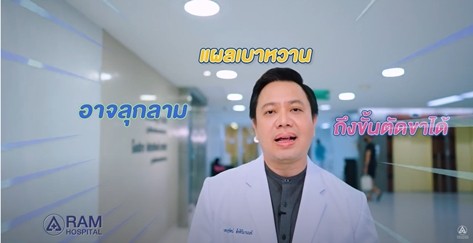Diabetic Foot Care Center
Centers and Programs

The Diabetic Foot Care Center, Ramkhamhaeng Hospital, provides care and treatment for diabetic foot ulcers under the supervision of a team of doctors and medical personnel specialized in diabetes and wound care. The hospital is committed to treating diabetic patients using advanced treatment technologies and appropriate methods to reduce the risk of ulcer progression and effectively promote patient recovery. Additionally, the center offers consultation on foot care to prevent future complications.
Ankle Brachial Index (ABI)
- The ankle-brachial index test compares your blood pressure measured at your ankle with your blood pressure measured at your arm.
- A low ankle-brachial index number can indicate narrowing or blockage of the arteries in your legs, leading to circulatory problems, heart disease, or stroke.
- The ankle-brachial index test is sometimes recommended as part of a series of three tests, including the carotid ultrasound and abdominal ultrasound, to check for blocked or narrowed arteries.


Diabetic Foot Disease: Necessity For Treatment
- People with diabetes are far more likely to have a foot or leg amputated than other people.
- The problem? Many people with diabetes have peripheral arterial disease (PAD), which reduces blood flow to the feet. Also, many people with diabetes have nerve disease, which reduces sensation.
- Together, these problems make it easy to get ulcers and infections that may lead to amputation.
- Most amputations are preventable with regular care and proper footwear.
- For these reasons, take good care of your feet and see your healthcare provider right away about foot problems.
- Always follow your healthcare provider's advice when caring for ulcers or other foot problems.
- One of the biggest threats to your feet is smoking. Smoking affects large and small blood vessels.
- It can cause decreased blood flow to the feet and make wounds heal slowly.
- A lot of people with diabetes who need amputations are smokers.
Diabetic Foot Ulcers Treatment
The management of diabetic foot ulcers requires offloading the wound by using appropriate therapeutic footwear, daily saline or similar dressings to provide a moist wound environment, debridement when necessary, antibiotic therapy if osteomyelitis or cellulitis is present, optimal control of blood glucose, and need evaluation and correction of peripheral arterial insufficiency.
Medical Technology
- Peripheral vascular disease is an important risk factor for lower extremity amputation in diabetic patients with chronic foot ulcers.
- Successful revascularization reduces the major amputation rate in diabetic patients.
- This can be achieved either by peripheral bypass or by percutaneous transluminal angioplasty (PTA).
- Recent studies are favoring peripheral angioplasty over traditional bypass surgery in diabetic lower limb.
PTA : The Innovation For Diabetic Foot Ulcer Treatment
- Angioplasty is a technique for unblocking blocked or narrowed arteries to improve blood flow.
- Local anesthetic is used to insert a fine catheter (tube) into the femoral artery in the groin and the catheter is manipulated to the site of the problem.
- Then a balloon is inflated to dilate the artery at the site of the block.
- This opens up the blood vessels and improves blood flow.
- Sometimes the result is improved by inserting a stent which is a fine metal mesh that provides support to keep the artery wide open after the balloon has been removed.
"Diabetic Patients" High Risk For Peripheral Arterial Disease (PAD)
- Peripheral artery disease is a condition in which the arteries in your legs or arms are narrowed or blocked. People with peripheral artery disease are at a high risk of heart attack, stroke, leg pain, foot ulcer, and major amputation.
- Given the inconsistencies of clinical findings in the diagnosis of PAD in diabetic patients, the measurement of ankle-brachial pressure index (ABI) has emerged as the relatively simple, non-invasive, and inexpensive diagnostic tool of choice.
Customer Testimonial
Mr. Huat Tangsittikorn

Diabetic Foot Ulcer: Mr. Huat Tangsittikorn's Story
"Mr. Huat Tang Sittikorn, who is 71 years old, told me that he had diabetes for 37 years. While the foot wound just happened a few years ago, with his daughter Ms. Siriporn helping to burden him. Taking care of the wound itself, brought him to the clinic and hospital. At first, the wound was only on the thumb but it treats for a year and still hasn't healed. And there are still more wounds until 4 toes have been amputated and the wound is beginning to spread to the fifth finger."
His relatives were seen on TV shows that at Ramkhamhaeng Hospital, there is a technique to widen blood vessels to help heal diabetic wounds. Therefore hurriedly brought him to contact for treatment immediately.
After Dr. Suthat accepted him for a thorough examination. Explained that it is caused by veins in the legs, which means the end of the blood vessel is blocked causing the blood to not flow to the toe. Therefore causing the wound that occurs that cannot be healed And the nerves in that area will not be perceived. He does not feel pain in the wound. And brought him to the color injection to see the condition of the peripheral vascular. It was found that the stenosis area was below the knee, and his veins or blood vessels had already become completely blocked by 2 of the 3 and the remaining ones were clogged at intervals. Includes 2 positions, each of which is 8 cm and 12 cm long.
Our doctors inserting the balloon into the blood vessels up to the constricted position and pumping air into it, inflating the balloon all around, resulting in immediate inflation of the blocked blood vessel, allowing blood to reach the toe. In time to survive the amputation of the remaining toe.
Customer Testimonial

Customer Testimonial

Customer Testimonial
Mr. Huat Tangsittikorn

Diabetic Foot Ulcer: Mr. Huat Tangsittikorn's Story
"Mr. Huat Tang Sittikorn, who is 71 years old, told me that he had diabetes for 37 years. While the foot wound just happened a few years ago, with his daughter Ms. Siriporn helping to burden him. Taking care of the wound itself, brought him to the clinic and hospital. At first, the wound was only on the thumb but it treats for a year and still hasn't healed. And there are still more wounds until 4 toes have been amputated and the wound is beginning to spread to the fifth finger."
His relatives were seen on TV shows that at Ramkhamhaeng Hospital, there is a technique to widen blood vessels to help heal diabetic wounds. Therefore hurriedly brought him to contact for treatment immediately.
After Dr. Suthat accepted him for a thorough examination. Explained that it is caused by veins in the legs, which means the end of the blood vessel is blocked causing the blood to not flow to the toe. Therefore causing the wound that occurs that cannot be healed And the nerves in that area will not be perceived. He does not feel pain in the wound. And brought him to the color injection to see the condition of the peripheral vascular. It was found that the stenosis area was below the knee, and his veins or blood vessels had already become completely blocked by 2 of the 3 and the remaining ones were clogged at intervals. Includes 2 positions, each of which is 8 cm and 12 cm long.
Our doctors inserting the balloon into the blood vessels up to the constricted position and pumping air into it, inflating the balloon all around, resulting in immediate inflation of the blocked blood vessel, allowing blood to reach the toe. In time to survive the amputation of the remaining toe.
Customer Testimonial

Customer Testimonial

















